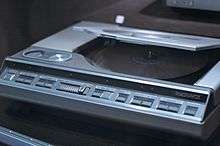Magnavox
 | |
| Subsidiary | |
| Industry | Consumer electronics |
| Founded | 1917 |
Key people | Edwin Pridham, Peter L. Jensen |
| Products | Odyssey (video game console), TVs, speakers, Blu-ray and DVD players, dehumidifiers, heaters, air conditioners, headphones, batteries |
| Parent | Philips |
| Website |
www |
Magnavox (Latin for "great voice") is an American electronics company founded in the United States. Today it is a subsidiary of electronics corporation Philips.
Magnavox was founded in 1917 by Edwin Pridham and Peter L. Jensen, inventor of the moving-coil loudspeaker two years earlier at their lab in Napa, California.[1] Magnavox later produced the Odyssey, the world's first home video game console.
Magnavox is the brand name worn by a line of products made by Funai under license from trademark owner Philips.[2]
History
Shortly after its launch, Magnavox became a major consumer electronics and defense company. It manufactured radios, TVs, and record players. In the 1960s Magnavox manufactured the first plasma panels for the military and for computer applications.
In 1972, Magnavox introduced the Odyssey, which was the world's first home video game console. The introduction of it triggered the beginning of the home video game console market. In 1974, the Magnavox Company was acquired by Philips, and all Philips consumer electronics in the US under the Norelco name began rebranding them under the Magnavox name; Philips acquired the similar-sounding company Philco in 1981, and Philips was able to freely use the Philips name, alternating with the Magnavox name for some electronics, with the personal care business continuing to use the Norelco name.
In the late 1970s, Philips developed "Laser Disc" technology, producing an optically read, 12 inch disc that would contain recorded video material. In the early 1980s, Philips worked with Sony to invent a standard for optical audio discs (CDs), using the technology developed for the "Laser Disc".
Teamed with Sony, Philips used the Magnavox brand name to introduce the CD-DA standard and equipment for consumer audio with the Magnavox player sold in department stores while the Sony CDP-101 went to high-end audio stores.
Philips acquired Magnavox's consumer electronics division in 1974, to ensure nationwide distribution for their VLP (later renamed LaserVision) Videodisc technology.
During the late 1970s the company released the Odyssey², also known as the Philips Videopac.
In the early 1980s, Philips merged Sylvania, Philco and Magnavox into one division headquartered in Knoxville, Tennessee, with a manufacturing plant in Greeneville, Tennessee. The Sylvania plant in Batavia, New York was closed and all operations moved to Greeneville. Philips also abandoned the Sylvania trademark which is owned by Osram.
In the late 1980s, Magnavox sold the Magnavox/Philips VideoWriter with some success. Released in 1985, the VideoWriter was a standalone fixed-application word processing machine (electronic typewriter).
Starting in the early 1990s, some Philips electronics were marketed under the brand name "Philips Magnavox", in an attempt to increase brand awareness of the Philips name in the United States. While it did work to a degree, it also caused confusion to the consumer as to the difference between "Philips Magnavox" products and "Philips" products, resulting in Philips marketing the two brands separately again.[3]


The defense group, centered on Fort Wayne, Indiana, remained independent under the Magnavox Electronic Systems name, first under Philips and later in the Carlyle Group, until it was acquired by Hughes Electronics in 1995.[4] The three areas of business of the MESC operation during the late 1980s and early 1990s were C-Cubed (Command, Control, and Communication), Electronic Warfare, and sonobuoys. When Hughes Electronics sold its aerospace and defense operations to Raytheon, the former Magnavox defense operations were transferred as well. Shortly thereafter, Raytheon spun off the sonobuoy operation to form Under Sea Systems Inc (USSI), in Columbia City, Indiana. In 1998, Raytheon sold USSI to a British defense consortium named Ultra Electronics[5] The company is now a wholly owned subsidiary of Ultra, manufacturing water and acoustic sensing and communications devices for military and civil defense.[6]
Among the defense products Magnavox manufactured were the AN/ARC-164 UHF radio, AN/SSQ-53 series sonobuoys, AN/ALQ-128 EW equipment, AN/SSQ-62 series sonobuoys, and the Advanced Field Artillery Data System (AFATDS).[7]
The brand also has worked with Funai with their televisions after the Philips Magnavox name was popular.
In Australia, the rights to the Magnavox brand are not owned by Philips but by Mistral Ltd, a Hong Kong trading company that uses it to sell audio/video equipment of a different make.[8]
In Europe, the brand Magnavox was briefly used in the 1990s by Philips on budget consumer electronics to replace traditional local brand names (such as Aristona, Erres, Hornyphon, Radiola, Siera). Since no one recognised the brand name, it was soon discontinued.
References
- ↑ Kornum, Rene. "The loudspeaker is 100 years old" Ingeniøren, 4 November 2015
- ↑ "MAGNAVOX". Magnavox.com. Retrieved 25 October 2014.
- ↑ "History of Philips Electronics North America Corp. – FundingUniverse". www.fundinguniverse.com. Retrieved 2016-09-28.
- ↑ "Ultra Electronics - USSI" (PDF). Whitleyedc.com. Retrieved 2016-08-19.
- ↑ Nathan Schueth. "Ultra Electronics — USSI, Innovation Through Experience". Ultra-ussi.com. Retrieved 25 October 2014.
- ↑
- ↑
External links
| Wikimedia Commons has media related to Magnavox. |
